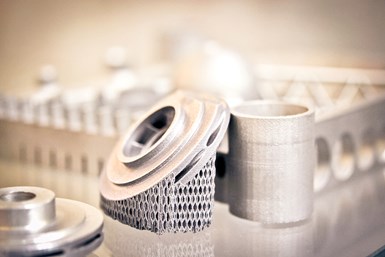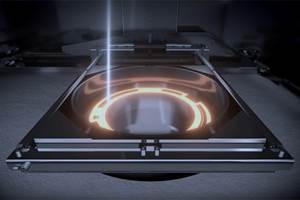Dyndrite Joins ASTM to Provide AM Reference Data
Collaborative effort aims to create shareable reference datasets that drive consistency across the industry, accelerating qualification and adoption of metal additive manufacturing.
Share
Read Next
Dyndrite has joined the ASTM International Consortium for Materials Data and Standardization (CMDS) initiative which is being run through the ASTM Additive Manufacturing Center of Excellence (AM CoE). The collaborative effort is designed to create shareable reference datasets that can help drive consistency across the industry, helping to accelerating qualification and adoption of metal AM.
Dyndrite is a provider of the GPU-accelerated computation engine used to create next-generation digital manufacturing hardware and software. The company will collaborate with industry members chartered to standardize the requirements for AM materials data generation, and create and manage shared high-pedigree reference datasets.
The company will create shareable standardized designs-of-experiments (DoE) build recipes across all major L-PBF OEM file formats. Dyndrite joins existing members such as AddUp, Auburn University, Boeing, Desktop Metal, EOS, Fraunhofer IAPT, GE Additive, GKN Additive and others.
“Dyndrite believes standardization is a crucial next step in the broader adoption and growth of industrial AM,” says Stephen Anderson, Dyndrite head of strategic relationships. “Whoever we talk to, the clarion call is clear. Our customers and partners all want to see significant acceleration of shared materials data to unlock new AM opportunities and to scale the industry. This is a groundbreaking opportunity to unleash the full power of metal 3D printing.”
To date, individual companies have singularly borne the brunt of materials development costs and regard their results as proprietary for commercial advantage. But this leads to multiple companies wasting dollars with each repetitively doing the same thing. CMDS’ work will help solve these problems by enabling the sharing of materials data at a fundamental level, while still enabling companies to generate IP and differentiate on specific geometry parameter modification.
Dyndrite recently unveiled its first end-user AM application, Dyndrite Materials and Process Development for laser bed powder fusion (LPBF). This GPU-based 3D application was designed for materials and process engineers developing new metal alloys and parts for laser-based 3D metal printing. It takes advantage of the features within Dyndrite’s Accelerated Computation Engine (ACE), including the ability to perform 3D geometric queries in order to detect and optimize for difficult geometric features such as domes, cantilevers, and thin walls. It also offers the ability to speed build rates by easily working with large multiple layer heights and print rates; methods to improve part quality by ensuring material homogeneity and controlling surface roughness; and support strategies said to delivery maximum flexibility. Customers using Dyndrite can also easily create shareable build recipes (Python) that provide all the necessary information required to recreate a build and drive a variety of 3D metal printers, including Aconity, EOS, Renishaw, SLM and others.
“We are pleased that Dyndrite has decided to join the CMDS initiative and prioritize the need to standardize the data workflows needed to generate high-pedigree material data,” says Richard Huff, ASTM director of industry consortia and partnerships. “We are excited to integrate Dyndrite’s solutions to drive consistent application of requirements and maximize efficiency of CMDS data generation activities.”
Dyndrite says it has built tools capable of ensuring quality and traceability through AM component production. “This is increasingly important as the metal AM industry moves to generate foundational material data built upon the Common Data Model,” says Steve Walton, Dyndrite head of product. “Our work enables knowledge transfer of critical material data and pedigree needed for robust characterization of the process-structure-property relationship. Understanding and effectively communicating this concept will greatly increase the adoption of metal AM for production applications.”
Dyndrite will release build recipes that demonstrate how standardized designs-of-experiments (DoE) — based on ASTM data standards — can be made using Dyndrite. ASTM members will be able to use these recipes, or make their own, across all major OEM file formats. These recipes will enable a common framework for build file generation, scan-path strategy exploration and scan-path speed and layer thickness variation, as well as methods for estimating laser(s) loads. By conforming to ASTM data protocols Dyndrite Build recipes will ensure that data is generated and recorded in a standard and repeatable manner, and applicable to downstream processes, such as process qualification and calibration.
- Read how Dyndrite and UPM are working to bring data intelligence to metal 3D printing build plates. The collaboration aims to reduce print failures and enable reliable supply chain for additive manufacturing production.
- Learn about Dyndrite’s collaboration with AMFG for cross-platform 3D metal automated production. AMFG powered by Dyndrite is an integrated solution that is said to unlock the full potential of metal 3D printing by bringing order-to-part automation, eliminating bottlenecks and streamlining the entire production process for increased efficiency and cost savings.
Related Content
Additive Manufacturing at NASA (Part 2): AM Radio #52
In this follow-up podcast episode on additive manufacturing at NASA, Dr. Tim Simpson joins us to discuss how the organization thinks about AM overall, and its role in advancing additive alongside and in service of commercial industry.
Read MoreVelo3D Sapphire Printers Become First Metal 3D Printers to Achieve DOD Green-Level STIG Compliance
The certification allows Sapphire printers to be connected to the DOD’s Secret Internet Protocol Router Network (SIPRNet) and gives customers confidence that their metal 3D printers are hardened against potential cyberattacks and other vulnerabilities.
Read MoreJeol’s Electron Beam 3D Printer Meets Aerospace Qualification Standard
The company says that meeting the AMS7032 operational qualification standard ensures manufacturers that Jeol’s JAM-5200EBM is capable of producing aerospace-grade material with stable performance and meets all material specification requirements.
Read MoreAdditive Manufacturing for Defense: Targeting Qualification
Targeting qualification in additive manufacturing for the defense industry means ensuring repeatability as well as reliability as there is much at stake, including human lives. Certain requirements therefore must be met by weapons systems used by the defense industry.
Read MoreRead Next
Postprocessing Steps and Costs for Metal 3D Printing
When your metal part is done 3D printing, you just pull it out of the machine and start using it, right? Not exactly.
Read MoreProfilometry-Based Indentation Plastometry (PIP) as an Alternative to Standard Tensile Testing
UK-based Plastometrex offers a benchtop testing device utilizing PIP to quickly and easily analyze the yield strength, tensile strength and uniform elongation of samples and even printed parts. The solution is particularly useful for additive manufacturing.
Read MoreBike Manufacturer Uses Additive Manufacturing to Create Lighter, More Complex, Customized Parts
Titanium bike frame manufacturer Hanglun Technology mixes precision casting with 3D printing to create bikes that offer increased speed and reduced turbulence during long-distance rides, offering a smoother, faster and more efficient cycling experience.
Read More





















